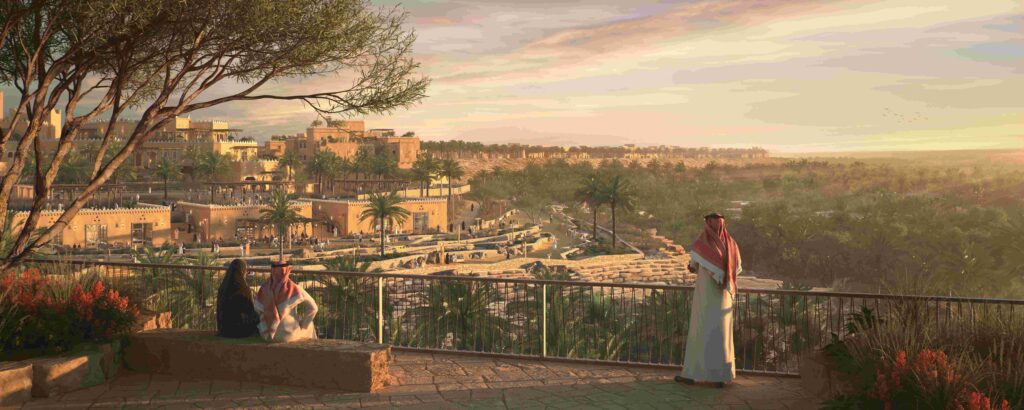People Spotlight: Meet Khaled Al Rawashdeh
Our People Spotlight series gives you an inside look at our technical experts around the world. This week, we are highlighting a project manager from our Buildings + Places business in Saudi Arabia and providing an insight into their inspiration and work.
Khaled Al Rawashdeh is a horticulturist with 23 years’ experience in landscape project management. Over the past two decades, he has worked on several large-scale landscape projects across three different climate zones in Amman, Jordan and the Red Sea area. Currently, he is the nursery and soft landscaping project manager working on the Diriyah Gate Phase II (DG II) in Riyadh.
Tell us about what inspired you to join the industry.
My decision to pursue a career in landscaping stemmed from its need for a unique blend of creativity and practicality. It provides me with a platform to express my innovative ideas while working in harmony with nature. Witnessing an ordinary space transform into a breathtaking spectacle brings me unparalleled joy, and I get a sense of accomplishment knowing that my efforts have brought about significant change. This profession provides me with a sense of fulfillment and satisfaction that is hard to find elsewhere. The opportunity to work for AECOM has enabled me to fulfill my needs for growth and to be part of one of the most iconic projects in the Kingdom of Saudi Arabia.
My decision to pursue a career in landscaping stemmed from its need for a unique blend of creativity and practicality. It provides me with a platform to express my innovative ideas while working in harmony with nature.”
What is your favorite AECOM project that you’ve worked on and why?
The project I hold in the highest regard from my tenure at AECOM is DG II, a project I had the privilege to directly contribute to that represents a pivotal moment in environmental and historic conservation. I take immense pride in being a part of it.
DG II is more than a project; it’s a symbol of historical, cultural and tourism evolution, central to Saudi Arabia’s Vision 2030. The objective is to transform the historic Ad-Diriyah area — a national treasure — into an iconic cultural cornerstone for the Kingdom of Saudi Arabia. The pedestrian-centric, multi-purpose development is set to become an authentic destination in Riyadh that features top tourist attractions. Critically, DG II embodies the principles of Environmental, Social, and Governance (ESG) principles, demonstrating a commitment to sustainable and responsible development.
For example, we are helping our client, the Diriyah Gate Development Authority with a green project to convert palm tree waste into fertilizer and animal feed, which will eliminate the practice of burning agricultural waste and thereby reduce carbon emissions This project is part of the broader Saudi Green Initiative to combat climate change, enhance quality of life for residents and visitors, and safeguard the environment for future generations.
The transformation of Diriyah and the Saudi Green Initiative are integral to Saudi Arabia’s broader commitment to sustainability and environmental stewardship, exemplifying the country’s efforts to balance development with preservation. At AECOM, we are proud to contribute to this transformative journey.
DG II is more than a project; it’s a symbol of historical, cultural and tourism evolution, central to Saudi Arabia’s Vision 2030. The objective is to transform the historic Ad-Diriyah area — a national treasure — into an iconic cultural cornerstone for the Kingdom of Saudi Arabia.”
Tell us a story of how your work positively impacted the community.
Currently, we are relocating 18,000 trees from DG II project in Riyadh. These trees will later be replanted within project areas. Some of these trees have certain historical importance in preserving the local Najdi community’s identity and heritage. Saving those trees instead of cutting them off will result in improving air quality and enhance carbon sequestration — let’s not forget that one tonne of CO2 can be offset by 31 to 46 trees.
Our sustainable landscaping practices offer a holistic approach to community development, fostering environmental stewardship, social cohesion and economic prosperity. We prioritize water conservation, pollution reduction, urban heat island mitigation and promote health and well-being.
Our sustainable landscaping practices offer a holistic approach to community development, fostering environmental stewardship, social cohesion and economic prosperity.”
Share a piece of career advice.
Continually strive for knowledge and keep networking. Build, nurture and maintain relationships with your colleagues. Develop resilience, adaptability and always be open to feedback. Embrace opportunities and understand that criticism and failure are stepping stones to success. Be proactive in seeking new opportunities and don’t shy away from challenges. Prioritize work-life balance and, most importantly, leave your comfort zone.








